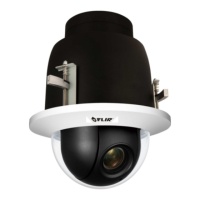This document does not contain any export-controlled information.
Configuration and Operation
84
Quasar CP-6302 Range User Guide - Ver. 8 - January 31, 2021
5.6.3.3 WDR Function
By default, the camera utilizes digital Wide Dynamic Range (dWDR), which improves the image quality
and amount of details in high contrast scenes. Such scenes combine areas with different lighting
conditions, where some areas are very bright and others are dark. If this function was not used, the
image either would be overexposed or too bright in bright areas and completely dark in dark areas. Digital
WDR helps to improve image quality by producing a larger amount of details in both the dark and bright
areas of the image.
The WDR function setting is adjustable among Off, Low, Mid and Hi. A higher level of WDR represents
wider dynamic range, so that the IP camera can capture a greater scale of brightness. The default setting
is Low. The setting is applied automatically.
Note:
1. When enabling Shutter WDR, be sure to select the corresponding PAL or NTSC WDR 2 Shutter
setting from the TV System drop-down menu on the Camera > Misc. screen.
2. Shutter WDR (True WDR) can be enabled from the Camera > Misc. screen as an alternative to
digital WDR. Shutter WDR is recommended for most lighting conditions.
3. When the frequency of a light source around the camera (including reflected light) is closely
synced with the Shutter WDR operation, a pixelization effect may appear. In these cases, it is
advised to use non-shutter WDR modes (such as NTSC 60). To change the mode, open the
web page and go to Settings > Camera > Misc. Select the appropriate TV system (NTSC
60/PAL 50). The camera will reboot. If the camera is attached to a VMS, rediscover the camera
after initialization.
5.6.3.4 Noise Reduction Settings
The noise reduction function consists of three settings:
·
3DNR
·
2DNR (Default setting)
·
ColorNR
Noise reduction settings are used to reduce or eliminate artifacts that can limit the ability to positively
identify an object. There are two types of noise: luminance and color (chroma) noise.
3DNR and 2DNR settings reduce luminance noise, which is composed of dots of various brightness
levels (black, white and gray) luminance noise contains dots of varying brightness levels (black, white,
and gray). It is not recommended to completely eliminate luminance noise, which can result in unnatural
images. 3DNR and 2DNR settings should be configured after configuring ColorNR.
3DNR
3DNR (3D Noise Reduction) provides superior noise reduction and is recommended for use in in extra
low-light conditions. It is especially useful for reducing blur with moving objects. The 3DNR function
reduces image noise/snow in low-light conditions by comparing adjacent frames. A higher level of 3DNR
generates relatively enhanced noise reduction, although it creates more motion blur than 2DNR on
moving objects.
The noise reduction is adjustable from Off, 3DNR Low, 3DNR Mid, and 3DNR Hi. The setting is applied
automatically.

